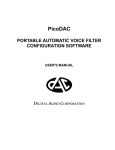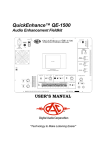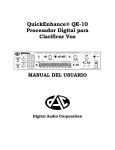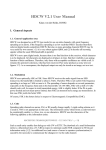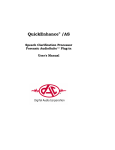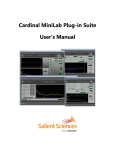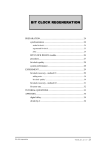Download PicoDAC User`s Manual
Transcript
PicoDAC PORTABLE AUTOMATIC VOICE FILTER Model PDAC256 USER’S MANUAL DIGITAL AUDIO CORPORATION A DRI COMPANY “Technology to Make Listening Easier” PicoDAC PORTABLE AUTOMATIC VOICE FILTER User’s Manual March 4, 2004 Document Number 960812 DIGITAL AUDIO CORPORATION A DRI Company 4018 Patriot Drive One Park Center, Suite 300 Durham, NC 27703 Phone: 877 5DACAUDIO Fax: 877 5DACFAX [email protected] www.dacaudio.com Copyright © 2004 by Digital Recorders, Inc. All rights reserved. TABLE OF CONTENTS 1.0 OVERVIEW ............................................................................................................... 3 1.1 Introduction ........................................................................................................... 3 1.2 Standard Filter Configurations .............................................................................. 3 1.3 Custom Filter Configurations................................................................................. 3 2.0 OPERATION ............................................................................................................. 5 2.1 Controls and Connectors ...................................................................................... 5 2.2 Typical Setups and Operating Instructions............................................................ 6 3.0 STANDARD FILTER CONFIGURATIONS ................................................................ 9 3.1 Preprogrammed Filter Setups ............................................................................... 9 3.2 Hints For Using The PicoDAC Adaptive Filter:.................................................... 10 4.0 CALIBRATION AND SERVICE ............................................................................... 13 4.1 Battery Replacement .......................................................................................... 13 5.0 PICODAC SPECIFICATIONS ................................................................................. 17 5.1 Analog................................................................................................................. 17 5.2 Digital .................................................................................................................. 17 5.3 Construction........................................................................................................ 17 1 LIST OF TABLES Table 1: Standard Filter Configuration............................................................................. 9 Table 2: Filter Bandwidths............................................................................................. 10 Table 3: Filter Size and Noise Types............................................................................. 11 LIST OF FIGURES Figure 1: PicoDAC........................................................................................................... 5 Figure 2. Basic Enhancement Setup ............................................................................... 7 Figure 3: PicoDAC Rear Panel Thumb Screws ............................................................. 13 Figure 4: PicoDAC Rear Panel Removal....................................................................... 14 Figure 5: PicoDAC Top Cover Removal........................................................................ 14 Figure 6: PicoDAC Battery Removal ............................................................................. 15 2 1.0 OVERVIEW 1.1 Introduction The PicoDAC digital filter is a compact, low-power digital filter intended for dedicated field signal processing applications. This powerful signal processor is fully self-contained and features: • • • • • • • Easy set up and operation Operation with live voice signals, tape recorders (all types), video cassette recorder, telephone, radio receiver, and body transmitter Low-power, 8-16 VDC operation, or internal 9V battery operation Compact enclosure (1.1" H x 2.8" W x 7.2" D) Bandwidths of 3.4, 5.0 and 7.5 kHz suitable for voice enhancement Ten selectable filters to cover most voice enhancement scenarios Two stages of 256th order, fixed and/or adaptive filters 1.2 Standard Filter Configurations The ten standard filter configurations in the PicoDAC are optimized for noise removal and clarification of live and recorded voice signals. The standard filter configurations consist of combinations of three different adaptive filter sizes at three bandwidths followed by either another short adaptive filter or a bandlimiting filter. The selected combinations of filter bandwidths and sizes allow the operator to easily customize the PicoDAC to a wide range of noise removal situations. Any of the ten filters can be rapidly selected with a front panel FILTER switch as detailed in Section 3.0. 1.3 Custom Filter Configurations Custom filter selections are also available for special applications. Please contact Digital Audio Company for further information. 3 4 2.0 OPERATION The PicoDAC is easy to setup and operate. The following section discusses the connections and controls for the unit. Following that, the remaining sections describe typical setups and how to select the best filter. 2.1 Controls and Connectors 2.8 1.1 6.4 Figure 1: PicoDAC Refer to Figure 1 for an illustration of the front panel controls. • The front panel INPUT rotary control adjusts the gain of the input signal. Immediately above this control is a tricolor Level LED that indicates input signal strength. Adjust the INPUT control so that the tricolor Level LED flashes green or occasionally yellow. Do not allow the input level to go into the red level or distortion may occur. • The FILTER rotary switch allows the selection of the desired filter by rotating the small arrow on the switch towards the desired filter number. The PicoDAC will automatically reset and load the filter whenever the FILTER setting is changed. 5 • The headphones can be plugged into the PHONES connector. Adjust the audio level with the VOLUME control beside the connector. • The two position Process/Bypass switch selects the state of the filter stages. To have the PicoDAC process (filter) the input signal flip the switch to PRO (Process). To have the PicoDAC bypass the two filter stages flip the switch to BYP (Bypass). • The red Power LED indicates that the PicoDAC is operating. Now refer to the Figure 1 illustration of the rear panel for the remaining controls. • The INPUT RCA jack is the PicoDAC’s input. This line level input allows the audio source to be input into the PicoDAC for filtering. If the PicoDAC is not powered, the INPUT signal is automatically routed to the OUTPUT jack. • The OUTPUT RCA jack is the PicoDAC’s filtered output. This line level signal can be connected to a copying tape recorder or loud speaker amplifier, if desired. If the PicoDAC is not powered, the INPUT signal is automatically routed to the OUTPUT jack. • The POWER connector mates to a 2.5 mm barrel plug. To power the unit connect the barrel plug of the AC to 12 VDC power adapter supplied with the unit to the POWER connector. The wiring guide for the plug is silk-screened on the rear panel. The PicoDAC is activated with the ON/OFF switch. If no connection is made to the POWER connector the PicoDAC is powered from two internal 9 V alkaline batteries. NOTE: The AC power adapter does not charge the internal batteries. • The RESET switch is used to restart the adaptive filters by pushing and releasing it. This function is particularly useful if the filter “crashed” and produces only noise in its output (a rare event when using the standard filters supplied with the PicoDAC). Another example of when to press the RESET switch is when the audio scene changes suddenly, requiring a new filter solution; this may occur when processing tape recorded conversations that occurred at different locations. The RESET switch does not clear the filter type and size settings nor affect the use of the FILTER selector switch, but it instead clears the filter coefficients; its effect is comparable to turning the power off and then back on. • The thumb screws are used to remove the PicoDAC top panel to access the batteries (refer to Section 4.1 Battery Replacement for more information). 2.2 Typical Setups and Operating Instructions Voice enhancement scenarios can take many forms. A basic enhancement setup is shown in Figure 2. For the basic enhancement setup, connect the original source audio to the INPUT connector on the rear panel of the PicoDAC. Notice in this example, a tape player is used as the original source. However, the signal could come from many different 6 types of sources such as a live microphone, cassette or micro-cassette recorder, DAT recorder, video cassette recorder, telephone, radio receiver or body transmitter. Connect a pair of stereo headphones to the front panel PHONES connector and a tape recorder to the rear panel OUTPUT connector to record the enhanced output. It is very important to note that the tape in the original source tape player is not altered in any way by the PicoDAC. Figure 2. Basic Enhancement Setup Now that the PicoDAC is connected properly, it is time to set the correct input levels for playback. Rotate both front panel knobs fully counter-clockwise and turn the PicoDAC on. Switch the front panel PRO/BYP switch to BYP, so the signal input will flow directly to the output without being altered. Now play the original source from the tape player, and adjust the front panel INPUT knob clockwise until the tricolor LEVEL LED flashes green. If this LED flashes in the red color region, then the knob has been turned too far; reduce the INPUT knob setting. Adjust the PHONES knob to a comfortable listening level. Once the levels are set properly, it is time to begin the voice enhancement process. Rotate the FILTER switch to a medium filter configuration position (e.g. switch position 3). Listen to the processed output. It may be necessary to change the selected filter configuration for best results; also, several different filter configurations may provide similar results. See the Section 3.1 for advice on selecting between the various voice enhancement configurations. Once the optimum filter configuration has been selected, rewind the original source tape player to the beginning of the tape, put the tape recorder connected to the PicoDAC OUTPUT connector into Record mode, press Play on the original source tape player, and create an enhanced version of the original source. 7 8 3.0 STANDARD FILTER CONFIGURATIONS 3.1 Preprogrammed Filter Setups The filters in the standard PicoDAC are optimized for noise cancellation to increase voice intelligibility. Simple noises are generally greatly attenuated. However, more complex noises such as those from bars or automobiles can only be modestly attenuated. The table below shows the characteristics of the filter selected by the front panel FILTER selector switch. FILTER Switch Setting Bandwidth (kHz) Adaptive Filter Size - Stage 1 (Noise Type) Filter Type- Stage 2 0 3.4 Medium (Normal Setting) High Pass (300 Hz) 1 3.4 Large (Complex Noises) Adaptive (Small) 2 5.0 Small (Simple Tones) High Pass (300 Hz) 3 5.0 Medium (Normal Setting) High Pass (300 Hz) 4 5.0 Large (Complex Noises) High Pass (300 Hz) 5 5.0 Large (Complex Noises) Adaptive (Small) 6 7.5 Small (Simple Tones) Band Pass (300-5000 Hz) 7 7.5 Medium (Normal Setting) Band Pass (300-5000 Hz) 8 7.5 Large (Complex Noises) Band Pass (300-5000 Hz) 9 7.5 Large (Complex Noises) Adaptive (Small) Table 1: Standard Filter Configuration The FILTER switch setting determines the signal bandwidth and type of filtering based upon the configuration programmed into the PicoDAC. When in the BYP mode, the PicoDAC simply bandlimits any audio applied to the INPUT connector and sends it to the OUTPUT connector, bypassing the audio filters. The ten standard filter configurations consist of three different adaptive filter sizes (small, medium, and large) at three bandwidths (3.4, 5.0, and 7.5 kHz) followed by either another small adaptive filter or bandlimiting filter (bandpass or highpass). The selected combinations of filter bandwidths and sizes allow the operator to easily customize the PicoDAC to a wide range of noise removal situations as explained in the following section. 9 3.2 Hints For Using The PicoDAC Adaptive Filter: • First, it is vital that the source material is prepared as carefully as possible. No amount of filtering will enable the operator to hear a voice that is not there. For example, if the source audio is from a tape recorder and the microphone is beside a loud air conditioner and the target voices are 40 feet away, it is doubtful any recoverable voice was recorded on the tape. (While this sounds like an unusual example - it does happen occasionally.) Also, if a tape player is used, make sure the heads are clean. • Next, select the appropriate bandwidth. The best results for adaptive filtering are achieved by matching the bandwidth of the PicoDAC to the bandwidth of the recorded voice. Table 2, below, can help select the best bandwidth. For example, if the input source is a telephone line that typically has a bandwidth of 3.4 kHz, use filters 0 and 1. Since the telephone line does not have any voice energy above 3.4 kHz, setting the PicoDAC for a higher bandwidth may elevate hiss noise above 3 kHz in the output audio. This added noise can make understanding the voice more difficult. Typical Equipment Bandwidth (kHz) FILTER Settings Telephone Line 3.4 0, 1 Microcassette Recorder, Body Transmitter 5.0 2, 3, 4, 5 Standard Cassette, Nagra Recorder 7.5 6, 7, 8, 9 Table 2: Filter Bandwidths • Lastly, listen to the unfiltered input and select the appropriate filter size. While selecting too large a filter will reduce simple noises, the remaining voice can become sterile or unnatural sounding. On the other hand, selecting too small a filter size may have less effect on complex noises. Select the initial filter size by referring to the table below, but feel free to experiment with the other filters and listen for the best results. 10 Filter Size Noise Type Examples Small (2, 6) Simple Noises Background music, tones Medium (0, 3, 7) Normal Setting Background music, tones, room reverberations. May provide superior quality. Large (1, 4, 5, 8, 9) Complex Noises Raspy hum or buzz Table 3: Filter Size and Noise Types 11 12 4.0 CALIBRATION AND SERVICE The PicoDAC is designed to make periodic calibration unnecessary. However, the two internal 9V batteries will periodically need changing. If for any reason the top cover is removed, the internal DIP switch settings must not be altered. (All switch positions must be set to OFF.) If service is needed, please contact Digital Audio Company for assistance. 4.1 Battery Replacement The normal running time for the PicoDAC on battery power is approximately 6 hours. To replace the 9V batteries: 1. First disconnect all cables from the unit (including the DC power cable.) Ensure that the rear power switch is in the OFF position. Loosen (using a flathead screwdriver) and remove the thumb screws (use a screwdriver if necessary) on the rear panel. Be careful not to damage any of the components in the PicoDAC by static electricity. Before opening the unit be sure to touch a grounded metal object. Figure 3: PicoDAC Rear Panel Thumb Screws 13 2. Remove the rear panel and bezel Figure 4: PicoDAC Rear Panel Removal 3. While holding the base of the unit, gently pull the black top cover toward the rear of the unit. Figure 5: PicoDAC Top Cover Removal 14 4. To remove the batteries push firmly on the back (the end opposite the terminals) of each battery in the direction of the terminals while prying upward. The battery should snap out of it’s clips back end first. Figure 6: PicoDAC Battery Removal To insert the new batteries simply reverse the previous action. First insert the terminal end of the battery by slowly prying it between the clips. Next press down on the body of the battery. It should snap into place. Ensure that it is making good contact with the connection terminals. Replace the top cover of the PicoDAC by sliding it back into place. Re-tighten the thumb screws and the PicoDAC is again ready to use. For applications where longer battery life is needed, longer life lithium batteries are available at many electronics stores. 15 16 5.0 PICODAC SPECIFICATIONS 5.1 Analog Line Input ·0.25 to 5.0 Vrms, panel adjustable, Zin = 50 kΩ ·Rear panel phono connector Line Output ·1 Vrms, Zout = 100 Ω ·Rear panel phono connector Phones Output · ·Suitable for stereo headset ·Front panel volume control and 3.5 mm stereo phones jack Analog Conversion ·16-bit sigma-delta A/D and D/A ·Selectable 9.0, 12.0, and 18.0 kHz sample rates ·(3.4, 5.0, and 7.5 kHz bandwidth). Level Indication ·Front panel tricolor LED: red (-3 dB), orange (-9 dB), green(-15 dB) 5.2 Digital Microprocessor ·TMS320F206 at 20 MIPS ·Dual DSP56200 Digital Filter Processor Program ROM ·32k x 16 Non-Volatile Flash Memory Filter Coefficient ·Non-Volatile Flash Memory Registers ·Input switch register (8 bits) ·Output LED register (3 bits) 5.3 Construction Enclosure ·Extruded aluminum with aluminum front and rear panels Size ·1.14" H x 2.75" W x 7.2" D overall Power ·8 - 16 VDC at 400 mA ·Cable and connector (2.1 mm barrel) supplied ·AC power adaptor supplied ·Two internal 9V batteries for portable operation 17





















